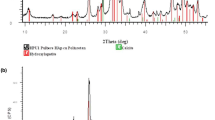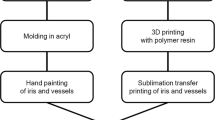Abstract
Floaters are aggregates of collagen that form inside the vitreous body. They originate by liquefaction of the vitreous and result in visual field distortions. In some cases, the patient discomfort is so severe that surgical removal is required, with the risk of consequent complications. However, floaters have yet to be fully studied and understood in the way and time they originate. The introduction of 3D printing boosted the development of new tools for scientific research such as bio-models. Bio-model applications range from surgical training to implants fabrication. Several models are also bioprinted as rigid scaffolds or bio inks containing living cells. Medical implants are often produced by Stereolithography (SLA) to build complex geometries and meet the desired mechanical properties with high-dimensional accuracies. This paper focuses on the optimization of the printing parameters of an SLA structure to obtain a scaffold with the required characteristic for a proper 3D cell culture and investigation. The model will be the starting point for a future study regarding the etiology and formation mechanism of eye floaters in cell culture. The studied 3D printing parameters are layer thickness, exposure time, and light blocker content added to a biocompatible resin. Due to the final application, the main required property of the scaffold is transparency that allows visual inspection under optical microscope. The selected samples showed a good biocompatibility and visibility under optical microscope, both promising results for long-term cell cultures.















Similar content being viewed by others
Availability of data and materials
Not applicable.
Code availability
Not applicable.
References
Lumi X, Hawlina M, Glavač D et al (2015) Ageing of the vitreous: from acute onset floaters and flashes to retinal detachment. Ageing Res Rev 21:71–77. https://doi.org/10.1016/j.arr.2015.03.006
Milston R, Madigan MC, Sebag J (2016) Vitreous floaters: etiology, diagnostics, and management. Surv Ophthalmol 61:211–227. https://doi.org/10.1016/j.survophthal.2015.11.008
Broadhead GK, Hong T, Chang AA (2020) To treat or not to treat: management options for symptomatic vitreous floaters. Asia Pac J Ophthalmol 9:96–103. https://doi.org/10.1097/APO.0000000000000276
Kalavar M, Hubschman S, Hudson J et al (2021) Evaluation of available online information regarding treatment for vitreous floaters. Semin Ophthalmol 36(1–2):58–63. https://doi.org/10.1080/08820538.2021.1887898
Cipolletta S, Beccarello A, Galan A (2012) A psychological perspective of eye floaters. Qual Health Res 22(11):1547–1558. https://doi.org/10.1177/1049732312456604
Kokavec J, Wu Z, Sherwin JC et al (2017) Nd:YAG laser vitreolysis versus pars plana vitrectomy for vitreous floaters. Cochrane Database Systc Rev Issue. https://doi.org/10.1002/14651858.CD011676.pub2
Ryan EH (2021) Current treatment strategies for symptomatic vitreous opacities. Curr Opin Ophthalmol 32(13):198–202. https://doi.org/10.1097/ICU.0000000000000752
Fenton OS, Paolini M, Andresen J et al (2020) Outlooks on three-dimensional printing for ocular biomaterials research. J Ocul Pharmacol Ther 36:7
Yap YL, Tan YSE, Tan HKJ et al (2017) 3D printed bio-models for medical applications. Rapid Prototyp J 23/2:227–235. https://doi.org/10.1108/RPJ-08-2015-0102
Sedlak J, Vocilka O, Slany M et al (2020) Design and production of eye prosthesis using 3D printing. MM Sci J. https://doi.org/10.17973/MMSJ.2020_03_2019127
Xie P, Hu Z, Zhang X et al (2014) Application of 3-dimensional printing technology to construct an eye model for fundus viewing study. PLoS One. https://doi.org/10.1371/journal.pone.0109373
Phan CM, Shukla M, Walther H et al (2021) Development of an in vitro blink model for ophthalmic drug deliver. Pharmaceutics. https://doi.org/10.3390/pharmaceutics13030300
Lobo DA, Ginestra PS (2019) Cell bioprinting: the 3D-bioplotter™ case. Materials 12(23):4005. https://doi.org/10.3390/ma12234005
Kupfer ME, Lin WH, Ravikumar V et al (2020) In situ expansion, differentiation, and electromechanical coupling of human cardiac muscle in a 3D bioprinted, chambered organoid. Circ Res 127:207–224. https://doi.org/10.1161/CIRCRESAHA.119.316155
Sommer AC, Blumenthal EZ (2019) Implementations of 3D printing in ophthalmology. Graefes Arch Clin Exp Ophthalmol 257:1815–1822. https://doi.org/10.1007/s00417-019-04312-3
Ferraro RM, Ginestra PS, Lanzi G et al (2017) Production of micro-patterned substrates to direct human iPSCs-derived neural stem cells orientation and interaction. Procedia CIRP 65:225–230. https://doi.org/10.1016/j.procir.2017.04.044
Ginestra PS, Pandini S, Ceretti E (2020) Hybrid multi-layered scaffolds produced via grain extrusion and electrospinning for 3D cell culture tests. Rapid Prototyp J 26(3):593–602. https://doi.org/10.1108/RPJ-03-2019-0079
StaAgueda JRH, Chen Q, Maalihan RD et al (2021) 3D printing of biomedically relevant polymer materials and biocompatibility. MRS Communications. https://doi.org/10.1557/s43579-021-00038-8
Schmidleithner C, Kalaskar DM (2018) Stereolithography. In: Cvetković D (ed) 3D Printing. IntechOpen, London. https://doi.org/10.5772/intechopen.78147
Kreß S, Schaller-Ammann R, Feiel J et al (2020) 3D printing of cell culture devices: assessment and prevention of the cytotoxicity of photopolymers for stereolithography. Materials. https://doi.org/10.3390/ma13133011
Funding
The authors did not receive support from any organization for the submitted work.
Author information
Authors and Affiliations
Contributions
All authors contributed to the study conception and design. Material preparation, data collection, and analysis were performed by LR, ELM, and PSG. The first draft of the manuscript was written by LR and ELM, and all authors commented on previous versions of the manuscript. All authors read and approved the final manuscript.
Corresponding author
Ethics declarations
Conflict of interest
The authors have no relevant financial or non-financial interests to disclose.
Additional information
Publisher's Note
Springer Nature remains neutral with regard to jurisdictional claims in published maps and institutional affiliations.
Rights and permissions
About this article
Cite this article
Riva, L., Mazzoldi, E.L., Ginestra, P.S. et al. Eye model for floaters’ studies: production of 3D printed scaffolds. Prog Addit Manuf 7, 1127–1140 (2022). https://doi.org/10.1007/s40964-022-00288-5
Received:
Accepted:
Published:
Issue Date:
DOI: https://doi.org/10.1007/s40964-022-00288-5




